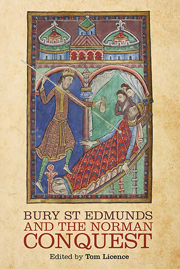Book contents
- Frontmatter
- Contents
- LIST OF ILLUSTRATIONS
- LIST OF MUSIC EXAMPLES
- LIST OF CONTRIBUTORS
- ACKNOWLEDGMENTS
- LIST OF ABBREVIATIONS
- Introduction
- 1 The Abbey and the Norman Conquest an Unusual Case?
- 2 Charters and Influences from Saint-Denis c. 1000–1070
- 3 The Abbey's Armoury of Charters
- 4 The Women of Bury St Edmunds
- 5 Baldwin's Church and the Effects of the Conquest
- 6 New Light on the Life and Work of Herman the Archdeacon
- 7 The Cult of St Edmund
- 8 St Edmund Between Liturgy and Hagiography
- 9 Books and their Use Across the Conquest
- 10 An Eleventh-Century Bury Medical Manuscript
- 11 Medicine at Bury in the Time of Abbot Baldwin
- 12 Medicine After Baldwin: The Evidence of BL, Royal 12. C. xxiv
- Index
1 - The Abbey and the Norman Conquest an Unusual Case?
Published online by Cambridge University Press: 05 August 2014
- Frontmatter
- Contents
- LIST OF ILLUSTRATIONS
- LIST OF MUSIC EXAMPLES
- LIST OF CONTRIBUTORS
- ACKNOWLEDGMENTS
- LIST OF ABBREVIATIONS
- Introduction
- 1 The Abbey and the Norman Conquest an Unusual Case?
- 2 Charters and Influences from Saint-Denis c. 1000–1070
- 3 The Abbey's Armoury of Charters
- 4 The Women of Bury St Edmunds
- 5 Baldwin's Church and the Effects of the Conquest
- 6 New Light on the Life and Work of Herman the Archdeacon
- 7 The Cult of St Edmund
- 8 St Edmund Between Liturgy and Hagiography
- 9 Books and their Use Across the Conquest
- 10 An Eleventh-Century Bury Medical Manuscript
- 11 Medicine at Bury in the Time of Abbot Baldwin
- 12 Medicine After Baldwin: The Evidence of BL, Royal 12. C. xxiv
- Index
Summary
The notion that the history of the abbey of Bury St Edmunds after the Norman Conquest was unusual is not new. William of Malmesbury in his Gesta pontificum described St Edmund as ‘the first of the saints of the country’. And in the Gesta regum he wrote that the saint's abbey was remarkable both for its capacity to attract patronage and to repulse tax-collectors:
By these arts he has so engaged the loyalty of all the inhabitants of Britain that anyone thinks it a privilege to enrich his monastery by even a penny. Even kings, the lords of other men, rejoice to call themselves his servants, and place their royal crown at his service, redeeming it at a great price if they wish to use it. The tax-collectors who run riot in other places, making no distinction between right and wrong, are on their knees before St Edmund, and stay their legal processes at his boundary-ditch, knowing from experience how many have suffered who have thought fit to persist.
A monk of the great Ile-de-France abbey of Saint-Denis, Abbot Baldwin of Bury St Edmunds (1065–97) was the one non-Englishman to be an abbot in England on the day that Harold lost the Battle of Hastings. He had first visited England well before his appointment to Bury in 1065 and been treated with great favour by King Edward.
- Type
- Chapter
- Information
- Bury St Edmunds and the Norman Conquest , pp. 5 - 21Publisher: Boydell & BrewerPrint publication year: 2014



